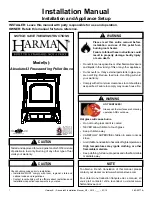
Page 8
of 16
FITTING
Before beginning the installation, please refer to the British Standard BS 8303 Code of Practice for installation
of domestic heating and cooking appliances burning solid mineral fuel and the current issues of British
Standards BS EN 15287-1:2007 design, installation and commissioning of chimneys.
CO Alarms:
Building regulations require that whenever a new or replacement fixed solid fuel or
wood/biomass appliance is installed in a dwelling a carbon monoxide alarm must be fitted in the
same room as the appliance. Further guidance on the installation of the carbon monoxide alarm is
available in BS EN 50292:2002 and from the alarm manufacturer’s instructions. Provision of an alarm
must not be considered a substitute for either installing the appliance correctly or ensuring regular
servicing and maintenance of the appliance and chimney system.
Ventilation:
may be required in accordance with the guidelines given in the Building Regulations.
Please refer to Approved Document J for more detailed guidance.
Chimney:
The chimney must be swept and examined for soundness and suitability before the
appliance is installed. Remedial action should be taken if required, seeking expert advice if
necessary. Where the chimney is believed to have previously served an open fire installation it
is possible that the higher flue gas temperature from a closed appliance may loosen deposits
that were previously firmly adhered, with the consequent risk of flue blockage. It is therefore
recommended that the chimney be swept a second time within a month of regular use after
installation.
Fasten the flue outlet and blanking plate to the top or back flue outlet
opening, on a thin bead of fire cement. Do not over tighten. Place the
stove on a non-combustible hearth conforming to building regulations,
noting the distances to combustible materials given in the table on the
front of this document.
Fix the stove securely to the earth by drilling through the fixing holes inside
the stove, into the hearth, with a 6mm masonry drill. Screw down with the
bolts and washers provided. If you chose to secure the stove using an
alternative method you should seal the two holes in the base of the stove
to prevent air being drawn in when the bottom valve is closed. Your stove
can be sealed to the chimney using a short (up to about 500mm) length
of uninsulated pipe in several ways, four of which are shown below.


































